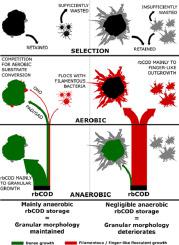Water Research ( IF 11.4 ) Pub Date : 2020-09-09 , DOI: 10.1016/j.watres.2020.116402 V A Haaksman 1 , M Mirghorayshi 2 , M C M van Loosdrecht 1 , M Pronk 3

|
Operational disturbances in aerobic granular sludge (AGS) systems can result in aerobic availability of readily biodegradable COD (rbCOD). Different from activated sludge, morphological consequences on the short and long term are not well described in literature. This study investigated the effect of incomplete anaerobic uptake of acetate on the morphological and process stability of AGS using a lab-scale reactor. A fraction of the total acetate load was dosed aerobically, which was increased stepwise while monitoring granular morphology. A good granular morphology and an SVI of 40 ml/g were obtained during initial enrichment and maintained for ≤20% aerobic acetate load dosed at 4 mg COD/g VSS/h. Biological phosphorus removal efficiency was initially unaffected, but the aerobic acetate dosage rate did decrease the aerobic phosphate uptake rate. This led to loss of phosphorus removal for >20% aerobic acetate load dosed at 8 mg COD/g VSS/h over the course of 12 days. Subsequently, significant outgrowth formed on the granular surfaces and developed over time into finger-like structures. Under these high aerobic acetate loads the SVI increased to 80 ml/g and resulted in significant biomass washout due to deteriorating settling properties of the sludge. The sludge settleability and biological phosphorus removal recovered 10 days after aerobic feeding of acetate was stopped. Aerobic presence of rbCOD can be tolerated if mostly anaerobic acetate uptake is maintained, thereby ensuring stable granular morphology and good settleability. The high enrichment of phosphate accumulating organisms in the granular sludge through bottom-feeding and selective wasting of flocs makes aerobic granular sludge resilient to morphological deterioration in aerobic presence of rbCOD.
中文翻译:

易于生物降解的COD的好氧可用性对好氧颗粒污泥形态稳定性的影响。
好氧颗粒污泥(AGS)系统中的操作干扰会导致易于生物降解的COD(rbCOD)的有氧可用性。与活性污泥不同,短期和长期的形态学后果在文献中没有得到很好的描述。这项研究使用实验室规模的反应器研究了乙酸不完全厌氧摄入对AGS的形态和工艺稳定性的影响。需氧量占总乙酸盐负荷的一部分,在监测颗粒形态时逐步增加。在初始富集过程中获得了良好的颗粒形态和SVI为40 ml / g,并维持了≤20%的好氧乙酸负荷,剂量为4 mg COD / g VSS / h。最初的生物除磷效率没有受到影响,但是好氧乙酸的添加速率确实降低了好氧磷酸盐的吸收速率。在12天的过程中,当剂量为8 mg COD / g VSS / h时,> 20%的好氧乙酸盐负荷导致磷的去除损失。随后,大量的产物在粒状表面上形成,并随时间发展成手指状结构。在这些高需氧乙酸盐负荷下,SVI增至80 ml / g,由于污泥的沉降性能恶化,导致大量生物质被冲出。停止好氧补给醋酸盐10天后,污泥沉降能力和生物除磷能力得到恢复。如果大多数厌氧乙酸盐的吸收得以维持,rbCOD的有氧存在是可以容忍的,从而确保稳定的颗粒形态和良好的沉降性。









































 京公网安备 11010802027423号
京公网安备 11010802027423号